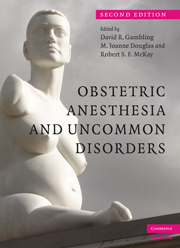Book contents
- Frontmatter
- Contents
- List of plates
- List of contributors
- Preface
- Section 1 Cardiovascular and respiratory disorders
- Section 2 Musculoskeletal disorders
- Section 3 Nervous system disorders
- 9 Disorders of the central nervous system in pregnancy
- 10 Spinal cord disorders
- 11 Peripheral neuropathy
- 12 Chronic pain in pregnancy
- Section 4 Metabolic disorders
- Section 5 Other disorders
- Index
- Plate Section
- References
11 - Peripheral neuropathy
from Section 3 - Nervous system disorders
Published online by Cambridge University Press: 19 October 2009
- Frontmatter
- Contents
- List of plates
- List of contributors
- Preface
- Section 1 Cardiovascular and respiratory disorders
- Section 2 Musculoskeletal disorders
- Section 3 Nervous system disorders
- 9 Disorders of the central nervous system in pregnancy
- 10 Spinal cord disorders
- 11 Peripheral neuropathy
- 12 Chronic pain in pregnancy
- Section 4 Metabolic disorders
- Section 5 Other disorders
- Index
- Plate Section
- References
Summary
Introduction
Peripheral neuropathy takes many forms and may occur as a primary condition or as a component of many diseases with multisystem manifestations. There are manifold etiologies: genetic, inflammatory, traumatic/compressive, metabolic, vasculitic, neoplastic, dietary, toxic/drug-induced. They may be classified as mononeuropathy, plexopathy, multifocal neuropathy (mononeuropathy multiplex), or polyneuropathy. They may affect primarily the cell body and/or the axon (neuropathy, axonopathy), or the myelin sheath (demyelinating neuropathy/neurapraxia). As these categories are confused and confusing, and of little use to the anesthesiologist, a simple etiological classification is used here (Table 11.1).
Neuropathies may affect sensory, motor, or autonomic nerves, or a combination. Longer neurons are usually the most susceptible, so a predominantly distal distribution is common. Signs and symptoms may include muscle weakness and wasting, peripheral in onset, usually affecting the lower limbs first, with loss of tendon reflexes and sometimes with fasciculation, glove and stocking sensory loss, paresthesias, spontaneous pain, and autonomic dysfunction.
Pregnancy may exacerbate some neuropathies, while pregnancy or parturition may be a direct or indirect cause of a variety of mononeuropathies and plexopathies, many of which may be incorrectly attributed to neuraxial anesthesia. Some peripheral neuropathies may alter drug sensitivity or impair respiration, and therefore present special challenges to the anesthesiologist. Pregnancy can also cause physical deterioration in restrictive respiratory disease, particularly if associated with scoliosis; it is important to remember that relief does not follow immediately after delivery, so the puerperium can be a dangerous time.
- Type
- Chapter
- Information
- Obstetric Anesthesia and Uncommon Disorders , pp. 215 - 228Publisher: Cambridge University PressPrint publication year: 2008
References
- 1
- Cited by



